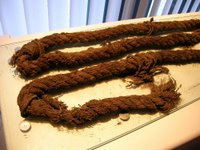A Rope Can Tell a Yarn.......
A few days ago I had the pleasure of joining Ole Magnus in the Conservation Lab where he and his wife, Annetta, have been sorting through Vasa's rope remains. Through months of work they have been re-cataloging all the rope finds and recording whatever information Ole's observations and expertise can bring to bear on them. It is impressive to watch him work, how quickly and easily Ole can spot crucial clues in the decayed fibers attesting to the way they were made, the materials used, and even the rope's history.
 Almost as soon as he unveiled this section of rope from its protective cover Ole was able to point out a half dozen fascinating characteristics. Hovering over the ancient piece of line, he showed me the unusual courseness of its fibers, posing the fascinating question, "Why would the grandest ship in the fleet have such mediocre material onboard?" There were even whole splinters of bark within the strands.
Almost as soon as he unveiled this section of rope from its protective cover Ole was able to point out a half dozen fascinating characteristics. Hovering over the ancient piece of line, he showed me the unusual courseness of its fibers, posing the fascinating question, "Why would the grandest ship in the fleet have such mediocre material onboard?" There were even whole splinters of bark within the strands.
Then Ole pointed to a line where the yarns were wound in a steeper spiral than other ropes and remarked that such a lay of the yarns indicated a history of heavy strain. Then directing my attention to a short section where the fibers were crushed flat, he added that the line was stretched long before it was ever put aboard the Vasa as the flattened spot indicated a knot that had been removed. Then he showed me a line made of two cords of varying thickness--the mark of an unskilled ropemaker, perhaps an apprentice.
 Ole told me that this line was a shroud taken from another vessel and stowed aboard Vasa as a spare. It had been heavily strained and every foot or so there was still a lashing where a ratline had been secured. It was deemed a spare because the ratlines were all cut off near the lashings and the heavy line was found in an enormous heap below decks.
Ole told me that this line was a shroud taken from another vessel and stowed aboard Vasa as a spare. It had been heavily strained and every foot or so there was still a lashing where a ratline had been secured. It was deemed a spare because the ratlines were all cut off near the lashings and the heavy line was found in an enormous heap below decks.
 Almost as soon as he unveiled this section of rope from its protective cover Ole was able to point out a half dozen fascinating characteristics. Hovering over the ancient piece of line, he showed me the unusual courseness of its fibers, posing the fascinating question, "Why would the grandest ship in the fleet have such mediocre material onboard?" There were even whole splinters of bark within the strands.
Almost as soon as he unveiled this section of rope from its protective cover Ole was able to point out a half dozen fascinating characteristics. Hovering over the ancient piece of line, he showed me the unusual courseness of its fibers, posing the fascinating question, "Why would the grandest ship in the fleet have such mediocre material onboard?" There were even whole splinters of bark within the strands. Then Ole pointed to a line where the yarns were wound in a steeper spiral than other ropes and remarked that such a lay of the yarns indicated a history of heavy strain. Then directing my attention to a short section where the fibers were crushed flat, he added that the line was stretched long before it was ever put aboard the Vasa as the flattened spot indicated a knot that had been removed. Then he showed me a line made of two cords of varying thickness--the mark of an unskilled ropemaker, perhaps an apprentice.
 Ole told me that this line was a shroud taken from another vessel and stowed aboard Vasa as a spare. It had been heavily strained and every foot or so there was still a lashing where a ratline had been secured. It was deemed a spare because the ratlines were all cut off near the lashings and the heavy line was found in an enormous heap below decks.
Ole told me that this line was a shroud taken from another vessel and stowed aboard Vasa as a spare. It had been heavily strained and every foot or so there was still a lashing where a ratline had been secured. It was deemed a spare because the ratlines were all cut off near the lashings and the heavy line was found in an enormous heap below decks.
1 Comments:
karen millen uk, ugg,uggs,uggs canada, ugg,ugg australia,ugg italia, pandora uk, canada goose, swarovski, louis vuitton, canada goose, nike air max, moncler uk, juicy couture outlet, moncler outlet, canada goose outlet, moncler outlet, canada goose, lancel, thomas sabo, pandora jewelry, gucci, louis vuitton, barbour, converse, moncler, moncler, replica watches, pandora jewelry, pandora charms, vans, montre pas cher, ugg uk, doke gabbana, supra shoes, hollister, canada goose outlet, louis vuitton, ray ban, ugg, links of london, converse outlet, coach outlet, canada goose uk, moncler, moncler, juicy couture outlet, canada goose outlet, louis vuitton, louis vuitton, toms shoes, canada goose jackets, barbour uk, marc jacobs, swarovski crystal,
Post a Comment
<< Home